
WeChat is 5 years old. Here’s how it’s grown
By Steven Millward for techinAsia.com
WeChat was born five years ago today. Here’s our potted history of China’s most essential app.
October 2010: In development
In a Tencent office in the southern Chinese city of Guangzhou, away from the company’s Shenzhen HQ, a small team starts working on a mobile chat app.
January 21, 2011: Tencent launches a messaging app
It started quietly on this day five years ago when Tencent, already China’s social media giant with its MSN-style QQ instant messenger and accompanying Qzone social network (with 780 million active users at the start of 2011), made a mobile-only messaging app. It was a big break from Tencent’s very PC-era social networks and online gaming empire.
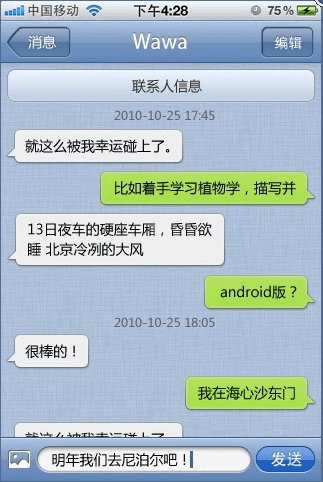
WeChat as it looked at launch. It was initially only available on iOS. Image credit: The Next Web.
The new app was called Weixin in Chinese. There was no English name yet. The Next Web, the only major news outlet to report the launch, transliterated the Chinese name and dubbed it “micro letters.”
China’s three telecoms companies already had online messaging apps that were proving popular, but Tencent wanted to bring down the telco barriers that existed between people and make a chat app that disrupted SMS and worked on any phone and on any mobile service – screw the telcos.
The launch of Weixin came as Kik and WhatsApp – both released in 2010 – were gaining traction. Neither Kik nor WhatsApp are blocked in China.
WeChat’s first iteration started out basic, with just text messaging, voice clips, and the ability to send photos.
August 2011: WeChat adds video clips
Anyone familiar with the dizzying array of features in Tencent’s other products would have guessed that WeChat would not stay so minimal for long.
Seven months after launching, WeChat updated to add in support for video clips and a “find nearby users” function.
With consumers slowly shifting from 2G to 3G, WeChat ensured that videos would be shrunk down to reduce the cost of sending them when not on wifi. A one-minute video could be condensed so that it was just 1MB in size.
March 2012: WeChat hits 100 million registered users
About 14 months after launching, WeChat hit a major milestone when Tencent reported it had 100 million registered users. This was before the company started revealing the number of monthly active users.
April 2012: Weixin becomes WeChat
After a year of Tech in Asia calling the app Weixin, Tencent picked an English name for it.
The move seemed to signal that the Chinese tech titan wanted to go global with its newest social network, something that the company has never done before.
Later that month, the v4.0 update of the app added in the Thai, Vietnamese, Indonesian, and Portuguese languages. It already had an English UI.
June 2012: WeChat goes after India
Tencent pushed WeChat into India with an official and high-profile launch – including lots of pricey ads on Facebook.

In search of the next billion in India. Photo credit: Meena Kadri.
The timing seemed great, as Indians were just about to join in the smartphone boom that was already sweeping China. But as we now know, India’s social media addicts love Facebook and WhatsApp.
It was the first of many overseas fails for WeChat.
July 2012: Voice and video calls added
The new features keep on coming.
July 2012: Alibaba tried to kill off WeChat
Seeing WeChat as an eventual threat to its ecommerce empire, Alibaba launched a WeChat-esque social app of its own.
It didn’t take off.
But Jack Ma was right to be worried about WeChat as Tencent’s wunderkind app later ventured into online shopping, in-store payments, and a number of other areas that tread on Alibaba’s toes.
Summer of 2012: Brands invade WeChat as QR codes swamp China
By the summer of 2012, a new trend was emerging – and it’s one that’s still very evident in China to this day.
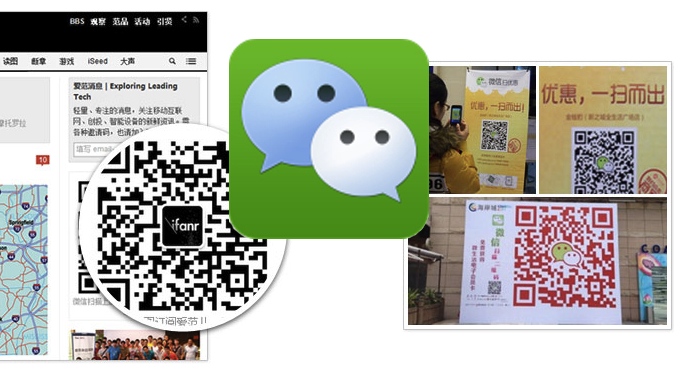
WeChat QR codes seen on the web and on the street in 2012.
Tencent opened up WeChat to brand accounts, prompting Chinese companies and foreign brands doing business in China to leap on board, keen to interact with China’s consumers in an arena that’s more direct and intimate than the Twitter-esque Weibo.
Media outlets and celebrities also rushed to get their own WeChat public accounts.
To get people to add and follow a brand account, a company could display its personalised QR code anywhere and encourage shoppers to scan it. This is how QR codes became ubiquitous in China.
Starbucks joined WeChat in September of that year.
September 2012: Syncs with Facebook and Twitter
By now, WeChat has animated emoji as well as downloadable sticker packs. In addition to all that, it allowed users outside China to connect their Facebook and Twitter accounts in order to find more buddies to add into the messaging app.
Facebook and Twitter are blocked in China.
The move shows that while some features are largely limited to the Chinese market – like the brand accounts – Tencent is still aiming at global expansion with a slimmed-down version of WeChat.
September 2012: WeChat hits 200 million registered users
The number of registered users doubled in the space of six months.
Late 2012: WeChat backlash begins
Now that the app is so big, stories of terrible things happening through it start to make national news in China. A woman was reportedly ambushed and murdered when a man who was stalking her using WeChat’s “people nearby feature” attempted to rob her.
That feature is switched off by default.
A few months after that attack, WeChat was implicated in the trial of a sexual predator who used the same location-based function to befriend and “groom” 160 boys, some aged under 13, who were living nearby.
December 2012: BlackBerry!
Back when BlackBerry was still clinging on to relevance, Tencent came out with WeChat for BlackBerry. It made sense as part of its expansion into new markets with lots of young phone users, like Indonesia, Malaysia, and a number of countries across the Middle East.
The BB10 version came much later, in July 2013.
January 2013: WeChat caught censoring users around the world
WeChat entered the global limelight in the worst possible way when it was seen censoring users around the world who entered certain politically sensitive phrases into the app.
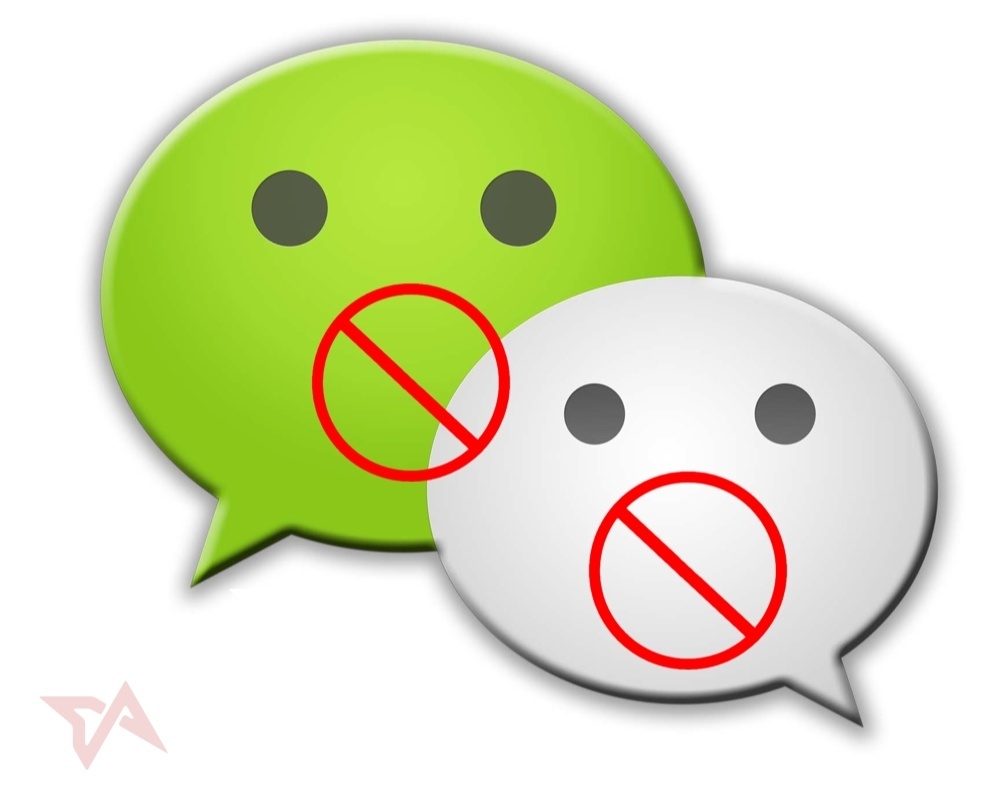
First reported by Tech in Asia, the development caused an international backlash against the app. It highlighted growing concerns of Chinese companies “exporting censorship” as they expanded overseas.
January 2013: 300 million registered users
The app reaches 300 million registered users just a few days after its second birthday.
February 2013: Weibo whacked by WeChat
By now, it’s clear that WeChat is huge and, along with its Facebook Wall-esque Moments section, it’s threatening to surpass Weibo as China’s favorite social app.
Charles Chao, CEO of Weibo parent company Sina, conceded to investors that there had been a dip in the amount of time that users were spending on Weibo.
February 2013: Hollywood glam
This is another threat to Weibo, which built itself on the appeal of interacting in real-time with big-name users. The likes of Selena Gomez, John Cusack, Maggie Q, Paris Hilton, Adam Lambert, and the Backstreet Boys all signed up to WeChat so as to engage with Chinese fans.
February 2013: WeChat chases after Indonesia
But, just as in India, not much came of this.
May 2013: A sign of progress in Thailand
Emulating the array of features and services being built into WeChat by companies in China, a major beverage firm in Thailand allows customers to order water deliveries from its WeChat brand account.
In the end, however, Line won the Thai market.
May 2013: WeChat finally reveals figure for monthly active users
It’s 190 million monthly active users (MAUs).
A month prior, WhatsApp revealed it had 200 million MAUs. While WeChat seemed poised to be bigger than WhatsApp at the time, the US-based app – later acquired by Facebook – would ultimately steam ahead as WeChat failed to grow substantially outside China.
July 2013: Messi shoots for WeChat

Lionel Messi’s WeChat billboard spotted in Hong Kong. Photo credit: Engadget’s Richard Lai.
Back when WeChat still seemed to have a good shot at going global, the company hired footballer Lionel Messi as its TV and billboard ad star.
August 2013: WeChat gets into gaming and mobile payments
With its latest update, WeChat adds in social gaming integration as Tencent published a handful of its own games. Third-party games later added in support for WeChat’s Games Center.
In another big move, the app now has mobile payments. It’s the start of the WeChat Wallet, which can be connected with a variety of Chinese-issued credit and debit cards. In time, these online and cashless in-store payments would expand to challenge ecommerce titan Alibaba.
August 2013: WeChat grows to 100 million registered users outside China
Messi scored a blinder for WeChat, boosting it to 100 million registered users outside of mainland China. However, no active user count was provided.
Tencent has never updated this figure, leaving media and analysts wondering if anyone outside China is using WeChat any more.
August 2013: Weibo launches WeChat rival spin-off app
Aaaaaaaaand that’s the last we ever heard of it.
September 2013: WeChat vending machines
During a month-long experiment, 300 WeChat-branded vending machines popped up in subway stations in parts of Beijing.

Photos from various people on Weibo.
After this, a few other vending machine companies incorporated cashless payments via WeChat’s Wallet – as well as Alibaba’s Alipay app. They’re now a fairly common sight across major Chinese cities.
November 2013: Xiaomi sells phones through WeChat
Selling stuff through WeChat is now common, so Xiaomi’s first experiment turned out to be indicative of things to come.
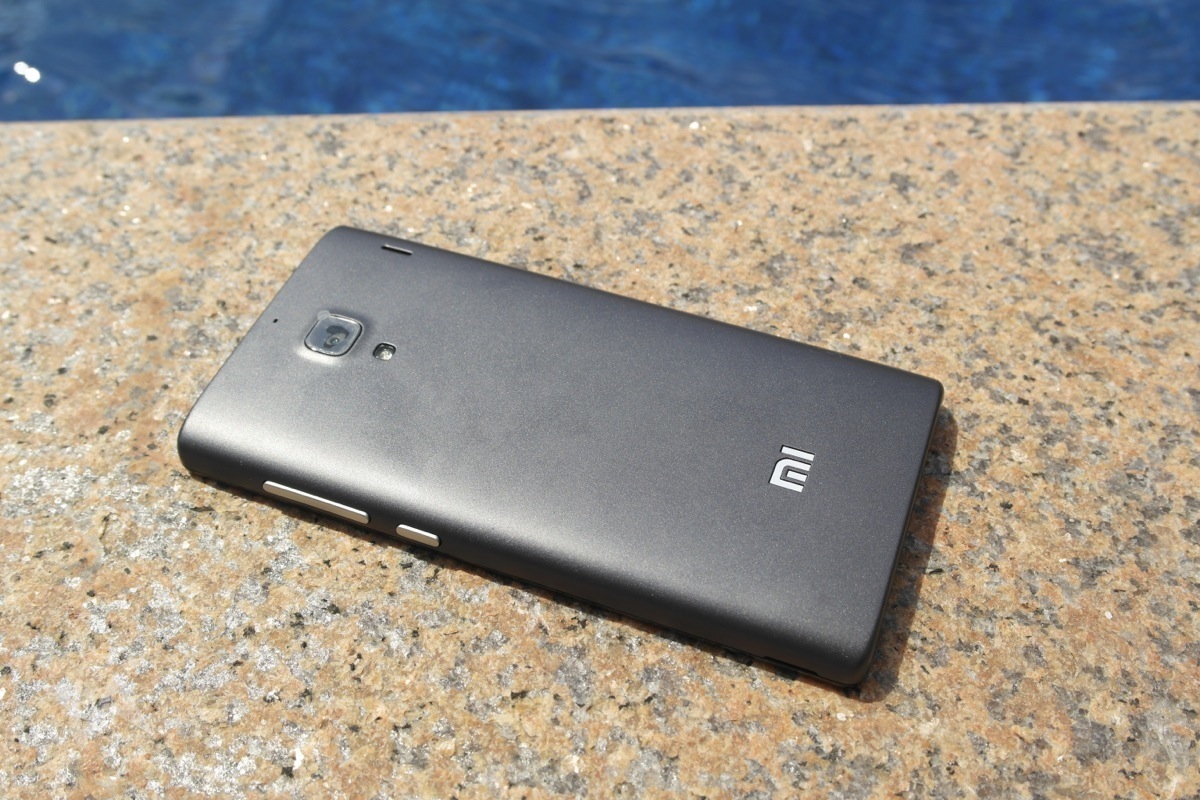
The Hongmi – later called the Redmi in overseas markets – was Xiaomi’s hot new budget phone in 2013.
Xiaomi sold 150,000 smartphones in less than 10 minutes in its WeChat-only flash sale.
January 2014: WeChat adds taxi booking
WeChat started 2014 with another big push into mobile commerce. The partnership with Didi Dache (which would later merge with its main rival, Kuaidi Dache) allowed people to hail a cab and pay for it all within WeChat, no cash required.

Photo credit: image by D’n’c.
This remains a popular feature in WeChat in China.
The move came days after Tencent contributed to a US$100 million funding round for Didi.
March 2014: Tencent boosts WeChat shopping cred with major investment
Tencent, which had been struggling with conventional ecommerce, took a stake in Alibaba nemesis JD. This allowed Tencent to embed JD’s store into WeChat as the main shopping area.
It was another direct taunt to Alibaba.
May 2014: WeChat stores
Building on the WeChat Wallet for mobile payments, Tencent now allowed any business to open a store inside a WeChat brand account. The feature was open to major companies as well as small businesses.

A WeChat store spotted in May 2014.
This is exactly what Jack Ma was so worried about.
June 2014: SMS nearly dead
SMS was declared pretty much dead in China mid-2014, with the average person sending just 1 SMS per day. I wonder how many are actually just spammers.
June 2014: Money transfers rolled out
WeChat’s mobile wallet got even more useful, allowing people to send money to their buddies.
Summer of 2014: Forget apps
A new trend was emerging in China that year: startups were not bothering building apps and were instead launching solely as a WeChat brand account.
“Users are increasingly spending more time within WeChat, time that’s taken away from other native apps. We are positioning ourselves in front of this trend,” a startup founder told us at the time. See the story here.
This trend is still ongoing in China.
September 2014: Pay for your ice cream with WeChat
In-store cashless payments have been on the cards since WeChat Wallet first appeared.
January 2015: Big brands dive into WeChat ads
WeChat started last year with a big move to bring in more money. The ads appear in the WeChat Moments feed (not in personal messages), allowing people to ‘like’ and comment on the ads just like any other Moments post.
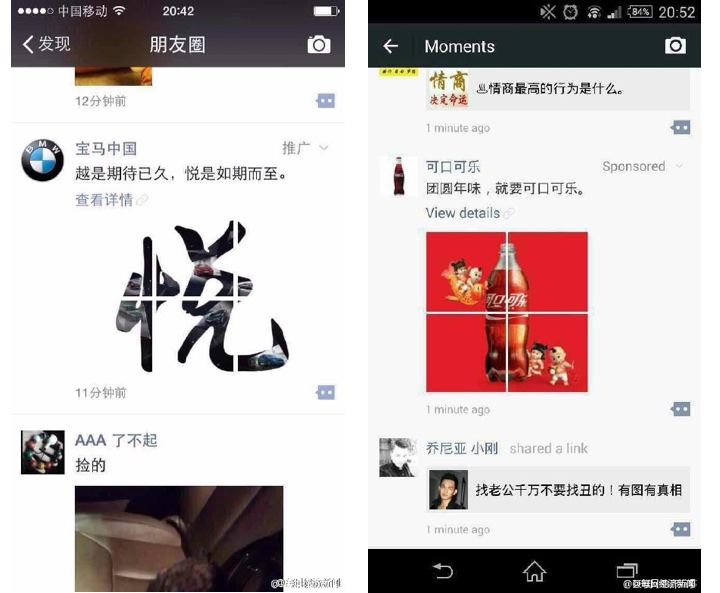
BMW and Coca-Cola showed the first ads.
March 2015: Half a billion
WeChat hit the insane milestone in Q4 2014 of 500 million MAUs, Tencent revealed in March.
March 2015: Uber blocked on WeChat
Uber’s official brand account got blocked on WeChat, revealing a dark side to WeChat’s huge influence on social media activity in China. The deletion of Uber’s brand account was a big blow to the US firm’s social media marketing and visibility in China.
Many people called foul since Tencent has a stake in Uber arch-rival Didi.
Tencent maintained that Uber’s account had violated the terms of service by offering deals or “enticing” users to share things with their friends. That’s considered a kind of spamming.
Uber returned to WeChat shortly after, only to be removed again in December.
July 2015: Report slams WeChat’s censorship
Being a Chinese company, Tencent has to self-censor WeChat a lot. That’s how the media works there. A report by Citizen Lab showed the full extent of the political manipulation in the app when its study revealed that 1.55 percent of posts made by brand accounts – like media outlets, brands, celebrities, and small companies – get removed after being posted.
Aside from all that, the report found evidence of censorship bots that block posts before they’re even published.
November 2015: 650 million!
650 million MAUs is the newest WeChat figure available.
Here’s a chart of every MAU figure the company has revealed:
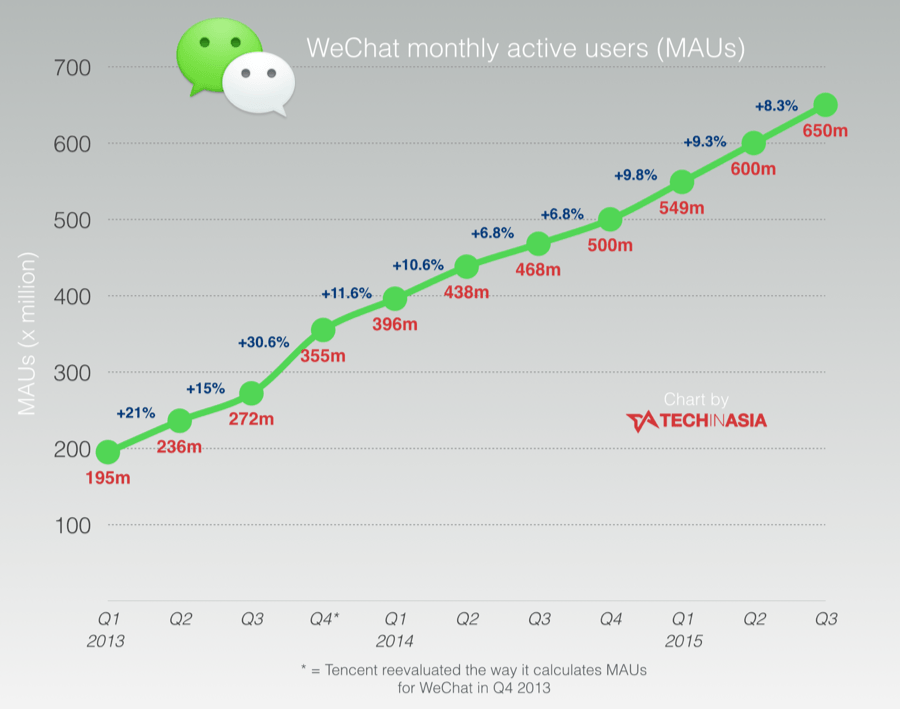
January 2016: WeChat used in courts
In a further sign of how pervasive WeChat now is in life in China, some judges in the country are now using WeChat’s text and photo-sharing features during trials.
The article first appeared in Tech in Asia magazine





